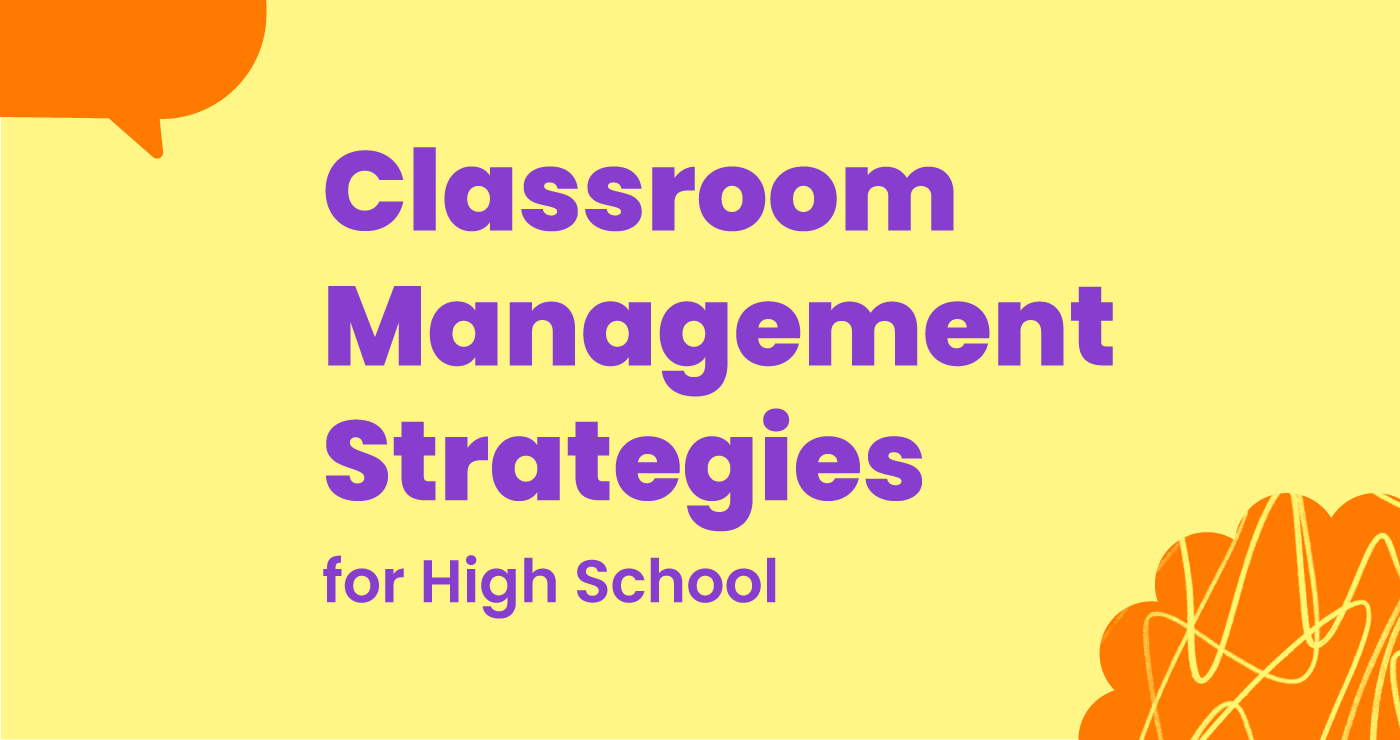It is interesting to note that effective classroom management strategies for high school play a pivotal role in shaping the young minds at schools. Hence, teachers, as the architects of academic spaces, should learn about these strategies and nurture the growth and development of the students.
However, applying these strategies amid the myriad challenges of adolescent behavior and diverse learning needs can be daunting. So, educators must learn the strategies well. In many cases, they know about classroom management strategies but fail to recollect them when the time comes. Also, sometimes, they face problems in selecting the right strategy.
If you, too, are facing these issues, we are here to help. In this blog, you will learn about some most effective classroom management strategies for high school. Moreover, you will learn some quick tips on how to manage the classroom in high schools. We will also discuss how to select the right strategy while managing the high school classroom. Finally, you will get some interesting FAQs.
Learn Classroom Management Strategies for High School
Managing a classroom, especially in high schools, is never easy. With a group of adolescent students, it becomes tough to handle. However, applying some smart and wise strategies can help to cope with this situation. Let’s see what these strategies are:
1. Establish Clear Expectations
One of the most effective classroom management strategies for high school is establishing clear expectations. By setting explicit guidelines for behavior, academic standards, and participation, teachers provide students with a roadmap for success. Moreover, clarity in expectations helps mitigate misunderstandings and reduce instances of disruptive behavior. By doing so, teachers create a collaborative learning environment where students feel valued and respected.
2. Enforce Benevolent Rules Consistently
Consistency is key to enforcing classroom rules. However, maintaining this consistency requires vigilance and dedication on the part of the teacher. While it may be tempting to overlook minor infractions or inconsistencies, doing so can undermine the teacher’s authority and disturb the classroom culture. Therefore, it is essential to address rule violations promptly and fairly. Thus, a sense of equity and fairness grows, fostering a positive learning environment for all.
3. Utilize Positive Reinforcement
In addition to addressing negative behavior, it is equally important to recognize and reinforce positive behavior. Positive reinforcement not only motivates students but also reinforces desired behaviors. It creates a culture of mutual respect and appreciation. Therefore, teachers should make a conscious effort to acknowledge and celebrate achievements, whether big or small. This can be done through verbal praise, written commendations, or tangible rewards.

4. Foster a Sense of Community
High school classrooms are microcosms of society, comprising students from diverse backgrounds and experiences. Therefore, fostering a sense of community is essential for creating an inclusive and supportive learning environment. Teachers can achieve this by promoting collaboration, empathy, and mutual respect among students. Group activities, team projects, and class discussions provide opportunities for students to connect with one another and appreciate their differences. Overall, teachers can create a classroom culture that values diversity and promotes acceptance.
5. Implement Engaging Instructional Strategies
Engagement is a powerful antidote to disruptive behavior. Therefore, it is essential for teachers to employ instructional strategies that capture students’ interest and imagination. Active learning techniques such as group work, hands-on activities, and multimedia presentations can enhance student engagement and reduce boredom. In addition, incorporating real-world examples and relevance into lessons can help students see the value and applicability of what they are learning. Thus, teachers can create an environment where students are motivated to participate and contribute actively to the learning process.
6. Promote Flexibility and Adaptability
Despite meticulous planning, no classroom operates in a vacuum. Unexpected disruptions, technological glitches, and individual student needs are inevitable. Hence, teachers must cultivate flexibility and adaptability in their approach to classroom management. Responding to students’ needs and adjusting instructional strategies can help maintain momentum and prevent disruptions. Moreover, cultivating a growth mindset and embracing challenges as opportunities for learning can model resilience and perseverance for students.
7. Cultivate Positive Relationships
Fostering positive relationships is one of the essential classroom management management strategies for high school. Building rapport with students establishes trust, communication, and mutual respect. It lays the foundation for a productive learning environment. To achieve this, teachers should take a genuine interest in students’ lives, offering support and encouragement. Also, they should be approachable and empathetic. Moreover, establishing open lines of communication with parents and caregivers can provide valuable insights into students’ needs and challenges.
How to Choose the Right Classroom Management Strategy for High Schools
We have discussed so far what are the major strategies that teachers need to focus on to manage high-school classrooms. However, it is important to keep in mind that applying the right strategy at the right time can only provide the best results. To decide on the right strategy among many, you, as a teacher, should be able to understand the situation well. Look at your students’ specific needs; understand their aspirations. Also, check the infrastructure you can access at schools. Thus, by looking at these factors, you will get an idea of which strategies need to be applied in that situation.
Quick Tips for Teachers to Manage Classrooms in High Schools:
- Establish clear rules and expectations for behavior and academic performance from the beginning of the school year.
- Enforce rules consistently and fairly to maintain classroom order and respect for authority.
- Recognize and praise students for following rules and meeting expectations, reinforcing positive behavior.
- Utilize engaging teaching methods, such as group activities, discussions, and multimedia presentations, to keep students actively involved in the learning process.
- Build positive relationships with students, show empathy, and provide support when needed to create a safe and inclusive classroom atmosphere.
- Address behavioral issues promptly and privately, using a proactive approach to prevent escalation.
- Involve students in decision-making processes, such as setting classroom rules or designing activities, to promote ownership and accountability.
- Be willing to adapt lesson plans and teaching strategies based on students’ needs and interests, maintaining flexibility in your approach.
- Maintain open lines of communication with students, parents, and colleagues to address concerns and collaborate on solutions.
- Lead by example by demonstrating respect for students, colleagues, and school policies, creating a positive classroom culture based on mutual respect and understanding.

Final Words
Applying classroom management strategies for high school is essential for creating environments where learning flourishes and students thrive. By establishing clear expectations, enforcing rules consistently, and fostering positive relationships, teachers can cultivate a culture of respect, collaboration, and engagement. Moreover, using engaging instructional strategies, promoting a sense of community, and embracing flexibility and adaptability can address the diverse needs of today’s high school students. Thus, by implementing these strategies, teachers can manage their classrooms at high schools well. Every student there feels valued, supported, and empowered to succeed.
Frequently Asked Questions (FAQs) on Classroom Management Strategies for High School
1. How can I effectively manage a classroom with diverse student needs and backgrounds?
To effectively manage a diverse classroom, it’s essential to create a culture of inclusivity and respect. Understand students’ behavior, promoting empathy and fellow-feeling among them. Implementing collaborative learning activities and fostering a sense of community can also help bridge cultural and socioeconomic gaps.
2. What should I do if a student consistently disrupts the class despite my efforts?
Addressing consistent disruptions requires applying some effective classroom strategies for high school. First, get into a private conversation with the student to understand the underlying reasons for their behavior and offer support or interventions accordingly. Then, involve the student in setting behavioral goals. If nedessary, collaborate with parents or guardians to develop a consistent approach to addressing the issue.
3. How can I maintain student engagement throughout the class period?
Keeping students engaged requires a variety of instructional strategies. To capture students’ interest, lessons should incorporate interactive activities, multimedia resources, and real-world examples. Moreover, teachers should provide opportunities such as project-based learning or flexible seating arrangements to increase motivation and engagement.
4. How can I handle conflicts or disagreements among students in the classroom?
Teach students effective communication strategies and encourage them to resolve conflicts peacefully and respectfully. It is one of the most important classroom management strategies for high school. Act as a mediator when necessary and help students find mutually beneficial solutions. Also, model positive conflict resolution behavior through your own actions and interactions with students.
5. What role do parents and other guardians play in classroom management?
As a teacher, you should establish open lines of communication with families to share information about classroom expectations, student progress, and behavioral concerns. You should also involve parents in decision-making processes and seek their input on strategies for supporting their child’s learning. Such collaboration creates a cohesive support system that ensures overall academic success at school.

Comments 0